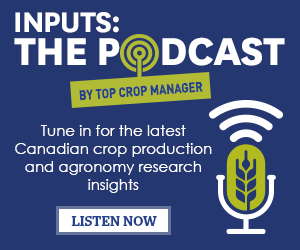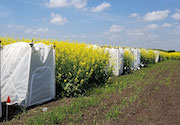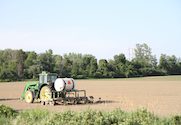| |
| |
 |
 |
| |
 |
|
@{mv_date_MMM d, yyyy}@ |
|
| |
 Last week saw warm, dry weather across much of Manitoba and Saskatchewan, which has caused many crops to develop rapidly. Grasshoppers are at or nearing economic thresholds in some areas.
» Read more...
Last week saw warm, dry weather across much of Manitoba and Saskatchewan, which has caused many crops to develop rapidly. Grasshoppers are at or nearing economic thresholds in some areas.
» Read more...
On July 30, Health Canada and the Canadian Food Inspection Agency confirmed that the DHA canola products produced by Nuseed Americas Inc. are safe for human and animal consumption.
» Read more...
If Aphanomyces root rot in pea and lentil crops isn’t enough, Saskatchewan Pulse Growers are working with local agronomists and chickpea farmers to identify an unknown crop health issue.
» Read more...
|
| |
 |
 |
| |
|
| |

While there are indicators that help predict disease prevalence in a growing season, the many factors that influence crop disease risk and severity keep farmers, agronomists and pathologists on their toes.
2020 has been a wet year for many on the Prairies, but this has less of an effect on crop disease than you may expect, according to Kelly Turkington, a plant pathologist with Agriculture and Agri-Food Canada in Lacombe, Alta. Turkington explains why infection levels vary by year, a variety of management methods, and the importance of pathologists in determining disease prevalence and severity.
>> Listen Now |
| |
|
| |
 Diamondback moth is a canola pest that can be a challenge to manage and control in outbreak years. Researchers at the University of Alberta are working to develop a better understanding of biological control – natural predators and parasitoids – of diamondback moth. Understanding the biocontrol these predators provide in the field shows their economic and environmental benefits for farmers.
» Learn more
Diamondback moth is a canola pest that can be a challenge to manage and control in outbreak years. Researchers at the University of Alberta are working to develop a better understanding of biological control – natural predators and parasitoids – of diamondback moth. Understanding the biocontrol these predators provide in the field shows their economic and environmental benefits for farmers.
» Learn more |
| |
 It’s often said that there’s no silver bullet in agriculture – you have to use all the tools in the toolbox. The most successful years require a perfect storm of choosing the right variety, ideal weather conditions, using the correct products to combat any weeds, insect pests or diseases that crop up and executing all the right best practices. And unfortunately, what works changes each year.
» Learn more
It’s often said that there’s no silver bullet in agriculture – you have to use all the tools in the toolbox. The most successful years require a perfect storm of choosing the right variety, ideal weather conditions, using the correct products to combat any weeds, insect pests or diseases that crop up and executing all the right best practices. And unfortunately, what works changes each year.
» Learn more |
| |
|
| |
 Mental health in agriculture is a popular topic, and yet it’s one that’s still not discussed
enough. Isolation, uncertainty, market volatility, high risks – the nature of the business makes
farmers particularly vulnerable. This episode features discussions about mental health in ag with Adelle Steward of the Do More Agriculture Foundation, and Shane Anderson of Tough Enough to Talk About It.
» Read More
Mental health in agriculture is a popular topic, and yet it’s one that’s still not discussed
enough. Isolation, uncertainty, market volatility, high risks – the nature of the business makes
farmers particularly vulnerable. This episode features discussions about mental health in ag with Adelle Steward of the Do More Agriculture Foundation, and Shane Anderson of Tough Enough to Talk About It.
» Read More
GMOs, pesticides, livestock health and safety: it can feel like farmers and consumers are
speaking different languages when hot button issues are discussed. In this episode, Kelly Daynard, executive director of Farm and Food Care Ontario, and John Jamieson, CEO of the Canadian Centre for Food Integrity, share the importance of building public trust in agriculture as a way to improve the conversation.
» Read More
|
| |
|
| |

OMAFRA canola specialist Meghan Moran says winter canola acreage in Ontario is expected to be higher than ever before.
» Read more
Cover crops are an effective weed management strategy following a cereal crop, especially for glyphosate-resistant weeds.
» Read more
AgScape, an Ontario organization that provides schools with fact-based agriculture and food education, received a $10,000 donation from Syngenta.
» Read more
|
| |
| |










